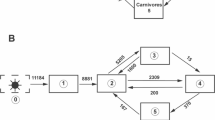Abstract
In this chapter I will try to answer the following questions: How should we apply thermodynamic methods and concepts to ecology; how can we describe the ecosystem’s behavior in the terms of physics (and particularly, thermodynamics); and what kind of physical criteria can be used for the estimation of anthropogenic impacts on ecosystems? From the viewpoint of thermodynamics, any ecosystem is an open system far from thermodynamic equilibrium, in which the entropy production is balanced by the outflow of entropy to the environment. I suggest the “entropy pump” hypothesis: that climatic, hydrological, soil and other environmental conditions are organized in such a way that only a natural ecosystem which is specific for these conditions can be in the dynamic equilibrium (steady state). In the framework of this hypothesis I can calculate the entropy production for an ecosystem under anthropogenic stress.
By considering systems far from thermodynamic equilibrium, we can prove that the so-called exergy is a functional of a dissipative function, which is undertaken along the trajectory going from a thermodynamic equilibrium to a dynamic one. It was shown there is a close connection between the measure of an additional information (Kullback measure) and the exergy.
And finally I try to show the deep internal connection between Lyapunov functions which are the main instruments of the stability theory and basic thermodynamic concepts, especially in applications to ecology.
“…nobody knows what entropy is in reality, that is why in the debate you will always have an advantage”
J. von Neumann
“Teleology is a lady no biologist can live without, but whose company seems shameful in society”
G. von Brükke
“Thermodynamics is full of highly scientific and charming terms and concepts, giving an impression of philosophical and scientific profundity. Entropy, thermal death of the Universe, ergodicity, statistical ensemble—all these words sound very impressive posed in any order. But, placed in the appropriate order, they can help us to find the solution of urgent practical problems. The problem is how to find this order…”
(from table-talks in Moscow)
Access this chapter
Tax calculation will be finalised at checkout
Purchases are for personal use only
Preview
Unable to display preview. Download preview PDF.
Similar content being viewed by others
References
Alexeev VV (1976) Biophysics of living communities. Uspekhi fisich eskikh nauk 120(4):647–676
Jørgensen SE (1992) Integration of ecosystem theories: a pattern. Kluwer Academic Publishers, Dordrecht Boston London
Kerner EH (1957) A Statistical mechanics of interacting biological species. Bull Math Biophys 19:121–146
Kerner EH (1959) Futher considerations on the statistical mechanics of biological associations. Bull Math Biophys 21:217–255
Khinchin AJ (1943) Mathematical foundations of statistical mechanics. Gostekhizdat, Moscow
Kullback S (1959) Information theory and statistics. Wiley, New York
Landau L, Lifshitz E (1964) Statistical physics. Nauka, Moscow
Larcher W (1976) Ökologie der Planzen. 2nd ed, Ulmer, Stutgart
MacArthur RH (1955) Fluctuations of animal population and a measure of community stability. Ecology 36:533–536
Malkin IG (1967) Theory of motion stability. Nauka, Moscow
Margalef RA (1951) A practical proposal to stability. Publ de Inst de Biol Apl Univ de Barselona 6:5–19
Rubin AB (1967) Thermodynamics of Biological Processes. Moscow Univ Press, Moscow
Schneider ED, Kay JJ (1994) Complexity and thermodynamics. Towards a new ecology. Futures 26(6):626–647
Svirezhev YM (1976) Vito Volterra and the modern mathematical ecology. In: Volterra V Mathematical theory of struggle for existence. Nauka, Moscow (the postscript to the Russian translation of this book)
Svirezhev YM (1990) Entropy as a measure of environmental degradation. Proc Int Conf Contaminated Soils, add. volume, Karlsruhe:26–27
Svirezhev YM (1997) Thermodynamics and ecology. Ecological Modelling (submitted)
Svirezhev YM, Logofet DO (1978) Stability of biological communities. Nauka, Moscow (English version: 1983, Mir, Moscow)
Svirezhev YM, Passekov VP (1990) Fundamentals of mathematical evolutionary genetics. Kluwer Academic Publishers, Dordrecht Boston London
Ulanowicz RE, Hannon BM (1987) Life and the production of entropy. Proc Royal Soc London 232:181–192
Weber BH, Depew DJ, Smith JD (eds) (1988) Entropy, information and evolution: new perspectives on physical and biological evolution. MIT Press, Cambridge, Massachusetts
Editor information
Editors and Affiliations
Rights and permissions
Copyright information
© 1998 Springer-Verlag Berlin Heidelberg
About this paper
Cite this paper
Svirezhev, Y. (1998). Thermodynamic Orientors: How to Use Thermodynamic Concepts in Ecology. In: Müller, F., Leupelt, M. (eds) Eco Targets, Goal Functions, and Orientors. Springer, Berlin, Heidelberg. https://doi.org/10.1007/978-3-642-58769-6_7
Download citation
DOI: https://doi.org/10.1007/978-3-642-58769-6_7
Publisher Name: Springer, Berlin, Heidelberg
Print ISBN: 978-3-642-63720-9
Online ISBN: 978-3-642-58769-6
eBook Packages: Springer Book Archive




